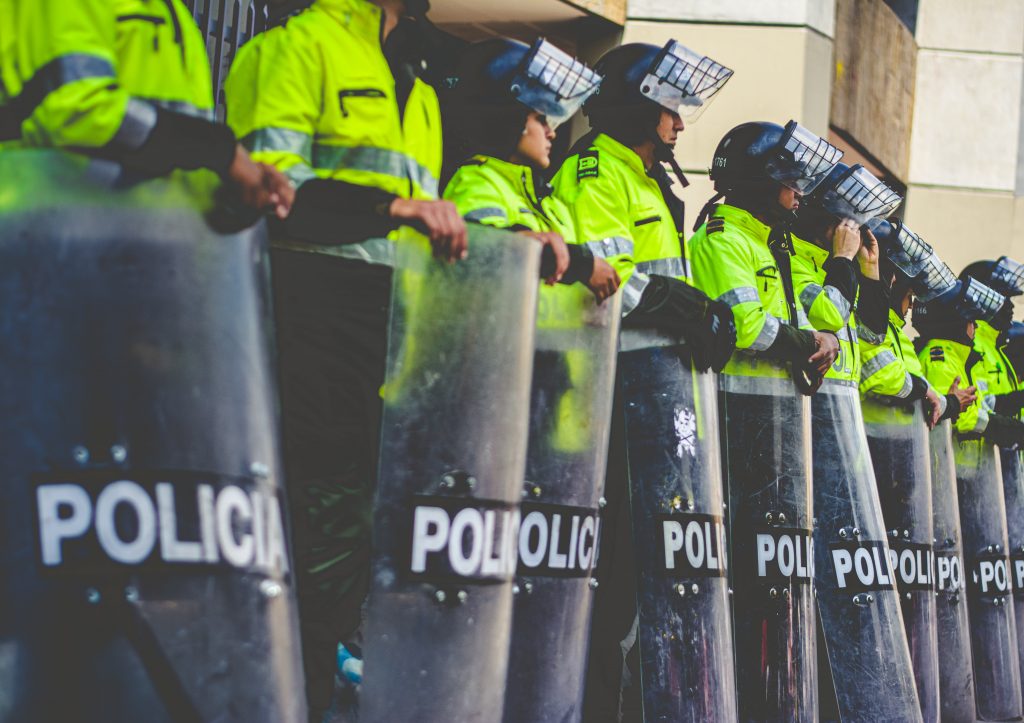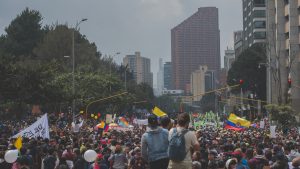By guest contributors Dhanshitha Ravi* and Rishabh Guha**
“…because here it’s easier to rain bullets than put food on tables.” – A Colombian protestor
INTRODUCTION
In April of 2021, Colombian conservative President Ivan Duque Marquez introduced tax reforms to bridge the fiscal deficit exacerbated by the pandemic which sparked the Paro Nacional 28A protests fueled by rampant corruption and inequality in healthcare across the country, the epicenter of which is traced to Cali. The President, an anathema to the netizens, deployed military personnel, the infamous mobile anti-riot squad (ESMAD) and labelled the peaceful protestors as ‘terrorists.’ Instances of police brutality were recorded leading to deaths, disappearances, and injuries using unrestrained force – violating human rights, contravening the Colombian Constitution and a multitude of international human rights conventions.

BACKGROUND
Firstly, in Operation Siloe, the guards used venom-system grenade launchers to fire directly into a candlelight vigil. The Popayan Court had previously ordered that such launchers firing non-lethal armaments like teargas must not be fired directly into the crowds, a life hazard causing grievous injuries. Secondly, the attack on the protestors of the indigenous Minga community in Cali was reported to be premeditated, owing to discriminatory statements uttered by the mayor, who denied the opportunity to claim the enforcement of their infringed rights. Lastly, the consequence of unbridled firing between May 28 and May 30 was innumerable casualties caused by armed civilians firing at the crowds, an outcome of the indirect acquiescence of the police force.
The repercussions of the military actions concerning the weapons employed, the death toll and people who succumbed to other forms of violence are essential to understand how these three outrageous incidents caused huge furor. Between April and July, the death toll stood at 44, along with the injury report that stood at approximately 1,400. More than 200 prisoners were detained arbitrarily, over 60 people had disappeared and innumerable cases of eye injuries as well as gender-based violence, including rape threats were reported.
The police forces have committed such atrocities on the people, not only limited to the three important events but also on a daily basis with irreconcilable monstrosities that disrupt the lives and activities of citizens. These incidents and reports highlight the genesis of the conflict that has not only resulted in tremendous loss of life but also the disruption of the state machinery to an extent that crumpled the pillars of human rights guaranteed by various domestic as well international laws.
CONTRAVENTION OF THE CONSTITUTION AND INTERNATIONAL CONVENTIONS
Human Rights is a central thread in the Colombian Constitution and it is the duty of the State to uphold it at all times. Article 214 prevents the suspension of human rights and fundamental freedoms. The premise has been grossly neglected by the officials when they blatantly abused various facets of human rights indiscriminately through unbridled mass firing into peaceful protestors. They have disrupted the tranquility and have injured peaceful citizens under the guise of maintaining public order through nonlethal means that have turned flipside instead.
Article 222 necessitates the inclusion of human rights’ values, during the training of public officials. Ironically, the police who are supposed to be guardians of people’s safety have instead been the element jeopardizing the life and limb of their fellow citizens. They have indulged in promoting the narcissistic views of the government who have aggrandized the presence of good intention that has been controlling the police who are mere puppets.
Article 278 empowers the Human Rights Department of the Office of the General Prosecutor, set up under Article 118 to encourage Congress to pass laws for the protection of human rights, and receives unjustifiable scrutiny from other sectors by impeding its work towards ameliorating the current plight of the citizens. Colombia is one of the few countries in America wherein the Police is under the Ministry of Defense along with the military. The General Prosecutor must recommend a law separating the two forces, limiting the weaponry and sensitizing the police forces to human rights issues. The soldiers are trained for armed conflicts, but not for citizens’ security.

Obligated to the American Declaration of Rights & Duties of Man, Colombia’s human rights practices are monitored by the Inter-American Commission on Human Rights and must ensure its compliance with international conventions. Colombia is also bound by the jurisdiction of the Inter-American Court of Human Rights undertaking cases regarding alleged human rights abuses, which makes it imperative for the Court to take suo motu cognizance of atrocities since the police forces are denying the right to the fair trial of victims.
Due to the UDHR being adopted by the UNGA, Colombia has the onus to foster the multifarious human rights enshrined in the document, including other treaties like ICCPR, CAT, and CEDAW. Some of the important rights include the right to life, liberty, and security (Article 3), prohibition of arbitrary detention or arrest (Article 9), right not to be discriminated against by guaranteeing equal protection of the law (Article 7), and the right to form unions for peaceful protests (Article 20). The Government has conveniently disregarded these inalienable rights enshrined in international laws since the police force had trespassed into the protesters’ bodily integrity and denied them the fundamental right of a fair legal trial. The most jarring instance of discrimination was the cataclysmic physical and verbal attacks on the Minga community.
THE WAY FORWARD
Recently President Duque introduced police reforms, as a desperate attempt to pacify the community, which has been criticized for being merely cosmetic. The reform incorporates provisions for creating a new department for submitting two reports on human rights violations, wearing body cameras by the squad, undergoing human rights courses and changing the uniform color from green to blue to portray an image of solidarity with the civilians. If implemented in tandem with Article 222 of the Colombian Constitution, then this reform could be effective in tackling the activities of the police by keeping a keen watch on their disproportionate measures.
Nevertheless, human rights activists believe that the Government is trying to put up a facade of bearing genuine intentions through a bid to ‘control the police,’ which is directly under the wing of the government. This reform is seen as toothless unless the relevant authorities are mobilized, to be a ray of hope for the citizens during such bleak times.
CONCLUSION
To create a conducive environment for the protection of human rights, the Government must take severe actions against officers violating human rights and provide compensation to the victims of violence. It is of paramount importance that the Office of the Prosecutor General intervenes and reprimands the President for his haphazard missteps of military deployment, infringing the promises that the State assumed. Such instances of police brutality in modern times shake the very foundation of human rights that have transformed dynamically to be comprehensive in nature and are frowned upon by the international fraternity. The Government must ensure that the promises through reforms are converted into practicality and periodically submit state reports to the concerned UN treaty bodies.
Authors
Photos
“Police, during #21N social protests in Colombia” – © Unsplash
“Protests in Colombia during #21N” – © Unsplash
